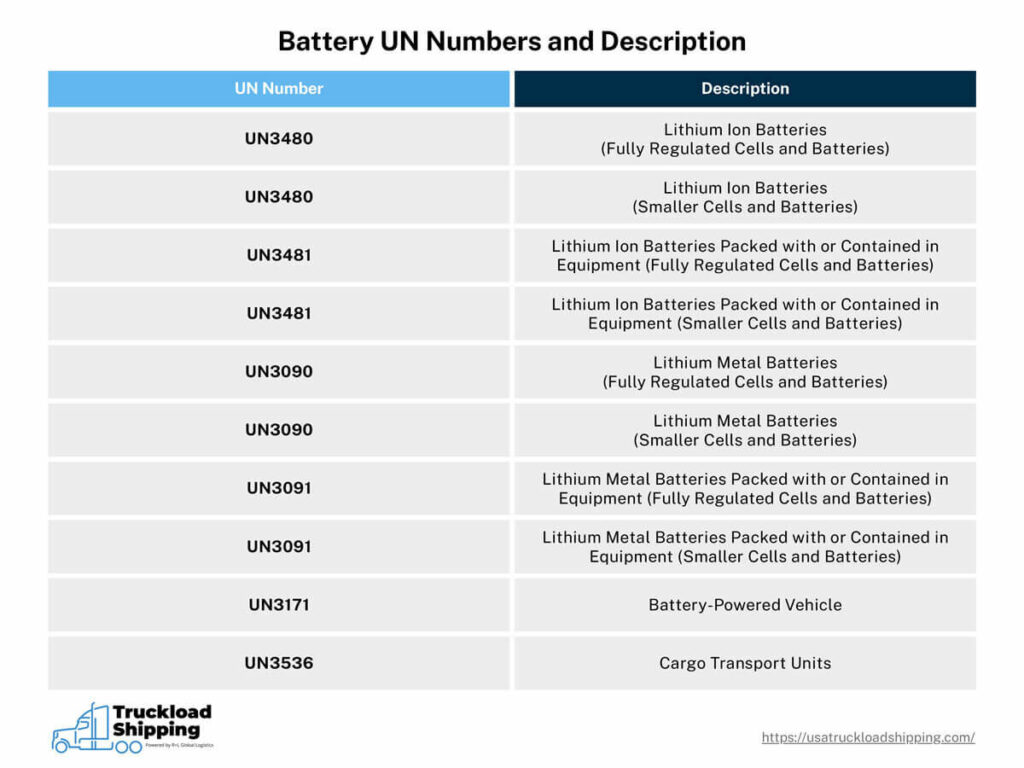Lithium batteries can be found in numerous devices that we use every day. However, they’re surprisingly dangerous to transport. As a shipper, you’ll be responsible for completing a variety of safety requirements before you move lithium batteries. Let’s take a look at the rules you’ll have to follow.
Key takeaways:
We’ll give you further information on each of these points to help you prepare your lithium battery shipment.
According to the Department of Transportation (DOT), lithium batteries are considered Class 9 hazardous materials. This applies to lithium batteries used in vehicles, consumer electronics, medical devices, and other items.
Lithium batteries pose numerous chemical and electrical hazards. For one, a fire can erupt if they overheat inside a trailer. These fires can be difficult to put out, and they often ignite other lithium cells and batteries in the shipment. If the batteries are located within devices already, shippers face additional losses.
As a result of these possible dangers, you’ll need to follow a variety of safety requirements when you ship these products.
DOT regulations for shipping lithium batteries are quite extensive. While many apply to carriers, there are certain responsibilities you’ll have to complete as a shipper of these items. We’ll go over these responsibilities in the following sections.
When it comes to hazard communication, it’s essential you know the UN ID number that applies to your lithium batteries. There are 10 in total, which we’ve included them in the following graphic.

Here are the hazard communication requirements for fully regulated cells and batteries:
Now let's take a look at the hazard communication requirements for smaller cells and batteries as measured by Watt-hour (WHh):
A lithium battery mark for shipments of smaller cells and batteries can be replaced with the UN ID number or phone number required for more information.
You’re probably not transporting battery powered vehicles and cargo transportation units. For the sake of simplicity, we’ll skip over the requirements for these products.
DOT requires you to follow strict packaging requirements to ensure the safety of your lithium batteries while they’re in transit. There are three universal rules that you should always follow when packaging your batteries.
Cells and batteries should be:
These three requirements aren’t the only rules you’ll have to follow. There are other guidelines that are specific to certain batteries. Consult DOT or meet with one of our transportation specialists to find out the rules you’ll have to complete.
Now that you’re finished with DOT’s hazard communication and packaging requirements, you can start preparing your freight for shipping. Fortunately, this process will be more straight forward than DOT’s guidelines.
A pallet is an efficient way to keep your freight organized and your batteries protected. Companies like Walmart and Costco all have different palletizing requirements. That said, there are some general rules you should follow.
You may want to find out if you can ship your batteries on a plastic pallet. Wood platforms are flammable and metal platforms are electrically conductive. Therefore, plastic pallets are a slightly safer option.
Related: Amazon Pallet Requirements
You should place at least two labels on your palletized load of batteries. Both labels must have the same information placed on each one.
This includes:
The size of your pallet label will vary based on the receiver of your freight, but 6” X 8” is a good measurement to use.
The most important shipping documents you’ll need to include with your batteries is the BoL and your hazmat paperwork. However, you’ll need to include a few other documents as well.
This includes:
Make sure you double-check your paperwork before shipping off your batteries. Any mistakes can lead to complications with your load.
You can use either full-truckload (FTL) or less-than truckload (LTL) to ship your lithium batteries. FTL is a great option if you have enough batteries to fill an entire trailer. It’s also cost-effective if you’re shipping over long distances. When you choose FTL, you’ll be charged a per mile rate.
For smaller shipments, LTL shipping is the option to use. Your shipment will share trailer space with other shipments. Costs for LTL are calculated using freight class and NMFC codes. Carriers frequently use both methods to ship freight, which means it’s not likely that you’ll have trouble finding capacity.
There’s always the risk of damage when it comes to shipping LTL or FTL freight. However, most of these freight shipments aren’t considered hazardous, like lithium batteries.
Obtaining cargo insurance for your lithium battery will protect you financially from losses that will occur if your shipment catches fire. It will raise the cost to ship your freight, but you won’t regret having it if something goes wrong.
While insurance is definitely helpful, it’s not required. However, if you are using LTL to ship, depending on the category of lithium-ion battery, a carrier may insist on a certain amount of cargo insurance.
You should consider your situation carefully before deciding if it’s a right fit for you load.
USA Truckload Shipping can take care of all your lithium battery shipping needs. With a network of over 22,000 carriers, we can find a provider that will transport your batteries with care. There are other shipping services that you’ll enjoy when you choose USA Truckload as your 3PL provider.
Start your shipping journey with USA Truckload Shipping by filling out your Request for Proposal (RFP) today. Completing this document will establish us as your long-term 3PL provider. You can also reach our team at (866) 353-7178 or our contact page if you have any questions about the services we have to offer.
R+L Global Logistics
315 NE 14th St., Ocala, FL 34470